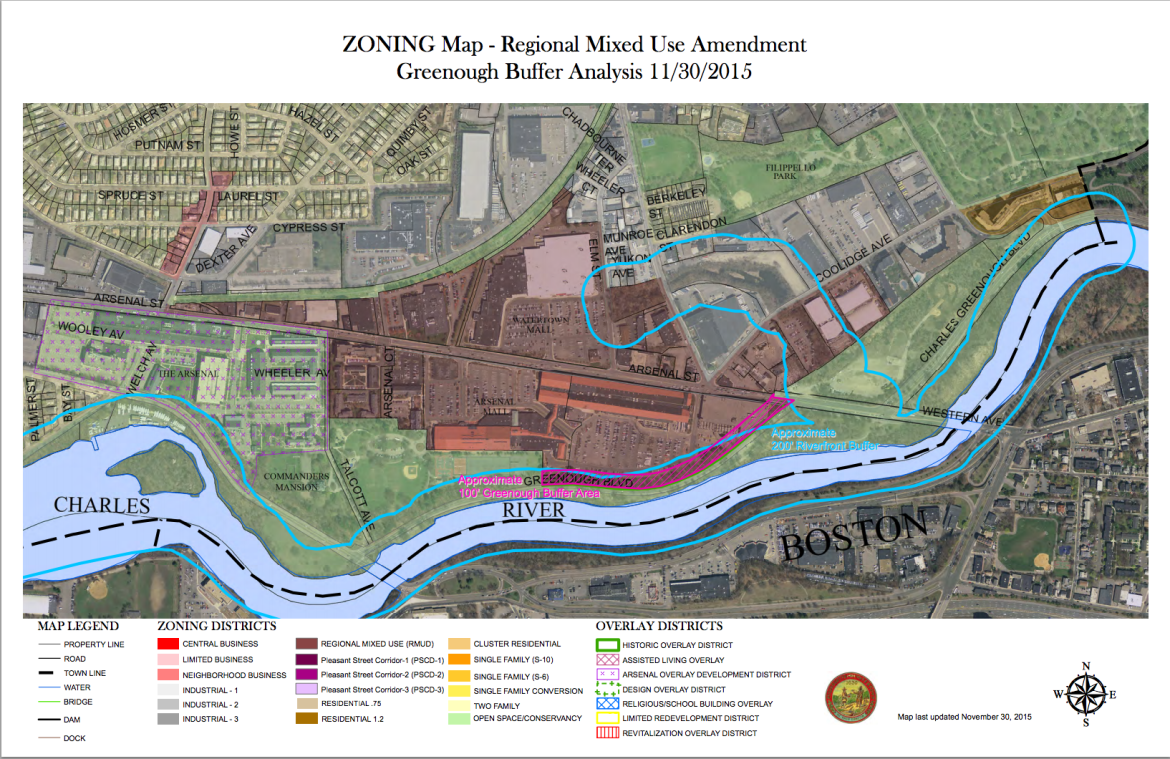
A map showing the RMUD buffer zones protecting the Charles River. The red lines show the town’s 100 foot buffer zone, the light blue show the 200 no-build zone under state laws.
The details of the proposed Regional Mixed Use District, or RMUD, were hashed out by a Town Council subcommittee, and councilors voted to allow the possibility of a tall building being built on top of what is now the Miller’s Ale House.
The vote came from the Economic Development and Planning Committee, which met Thursday to continue to make their recommendations for possible amendments to the proposed major zoning change. The full Town Council will discuss and vote on the RMUD at a meeting scheduled for Monday, Feb. 8 at 6:30 p.m. in Town Hall.
The possibility of building a building of 10 stories or even higher is one of the most controversial parts of the zoning proposal. The zoning would impact the area where the Arsenal Project and Arsenal Mall sit, some other properties farther east and west of the malls on Arsenal Street, and parts of Elm Street and Coolidge Avenue.
An amendment proposed by resident Jonathan Bokian would have not allowed any building within a 100-foot buffer zone intended to protect the Charles River. The town proposed to make an exception for buildings already in the zone, but the amendment would have changed that and impacted fair sized chunk of the building where Miller’s Ale House is located.
The building is owned by Boylston Properties, which also owns the former Arsenal Mall and seeks to make significant changes to the property – but mostly near the other side of the mall. The foundation of the building would allow for a tall building. It was built strong so it could be a munitions storage when it was part of the U.S. Army’s Watertown Arsenal.
Councilor Vincent Piccirilli said that while the building is in the buffer zone, the zone is marked from the edge of Greenough Boulevard. In that spot it is farther from the river that most parts of the buffer zone.
“It is not that close to the river, since (the road) curves as it comes to Arsenal Street,” Piccirilli said. “It seems like we are trying to overthink this corner.”
The subcommittee voted 3-0 against the amendment.
Reversal of Decision on Buffer Zone
At the subcommittee’s meeting in December, members approved an amendment which would allow a swap of land in the buffer zone up to 25 feet toward the river, but it would be replaced with double the amount of space at another spot connected to the buffer zone.
Some residents did not want to see any building closer than the 100 foot buffer, and opposed the amendment. Councilor Kenneth Woodland, however, said he liked the idea, and the fact that the swap would provide more open space.
Councilor Susan Falkoff, who originally proposed the amendment, said she had thought more about the proposal and changed her mind.
The subcommittee voted 2-1 against supporting the swap of land in the buffer zone, with Woodland voting for it.
No to Step Backs Near Open Space
Another amendment would have required a “step back” for stories above 55 feet high on buildings that is within 50 feet of Open Space Conservancy Land. The step back require the facade of the building facing the conservancy land to be one foot away from the conservancy land for every foot of height. This would create a 45 degree line of sight under which the section of the building over 55 feet tall would have to fit.
Bokian also proposed this amendment, and argued that he did not want a “canyonization” of the open space areas, with tall buildings looming over them.
Senior Town Planner Gideon Schreiber said the 100-foot buffer zone would not be considered Open Space Conservancy land.
The RMUD has Open Space Conservancy land on most sides, including the Charles River and the Watertown-Cambridge Greenway (also called the Community Path) behind the Watertown Mall, along with some ponds and brooks in the middle.
This amendment would make it very difficult to construct a tall building, said Eric Brown, the architect working with Boylston Properties.
“You can’t build a building that way if you want to have an (energy) efficient building and rent it out at rates that you want to have,” Brown said, adding that it would create more surface area, making it more inefficient.
Also, the buildings being considered would likely be about 60-feet wide, and after a couple floors the space would be so limited they could not build any higher, said Tom Wilder, of Wilder Companies, which operates the Arsenal Project.
The subcommittee voted 3-0 against the proposed amendment.
Most of the other proposed amendments were voted down by the subcommittee, including limiting the length of a facade, requiring independent stores and prohibiting big box stores
The subcommittee did approve wording to protect and clean up bodies of water in the RMUD, including Sawins and Williams ponds and the Charles River.
The Economic Development and Planning subcommittee will finish going through the proposed amendments on Tuesday, Feb. 2 at 7 p.m. in Town Hall.